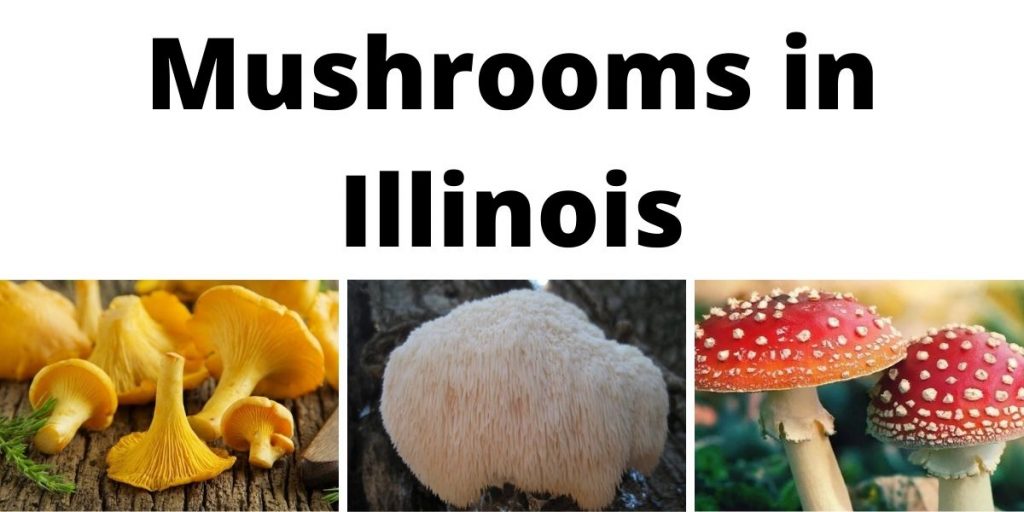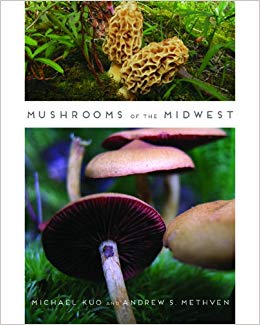Illinois has its fair share of mushroom species[i], many of which are edible. Some are very much not. There is no way an article like this can cover all of the mushroom species found across an entire state, but we can give an introduction to some of the more interesting kinds.
It’s important to be cautious with edible mushrooms, not because mushroom identification is inherently more difficult than plant identification, but because so few people really know how to do it—and few understand what it really involves. Please don’t be the person who takes a photo, posts it to an online forum for identification by strangers of unknown qualification, and then eats the thing. Instead, either consult an expert in person or become an expert.
The other problem is than many mushrooms are good to eat in some circumstances by some people, while making other people sick. For some, the critical factor is known and illness can be avoided, but for others it is not. And for some, edibility itself is the subject of fierce debate. Some real study is necessary to make sense of it all.
I cannot emphasize enough that this list is an introductory guide and not to be used in place of a field guide, spore prints, or an identification app. It is even better if you can find a local guide in your area to help you in person. If you do end up going out mushroom hunting make sure you take a quality knife with you and a basket/bag for your finds!
Our Recommended Field Guides for Illinois
COVER | TITLE | Header | ||
|---|---|---|---|---|
OUR #1 RATED | ||||
Edible Wild Mushrooms in Illinois
Morels (Morchella sp.)
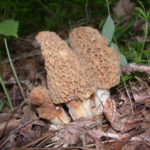
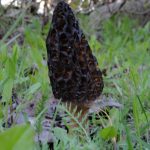
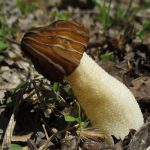
Illinois is famous for its morels, a delicious, if odd-looking, group of fungi that typically fruit in the spring[ii]. Instead of the umbrella shape of many mushrooms, morels are more like a thimble on a finger, with the spores released from large pits in the outer surface of the thimble-shaped cap. The group does have some toxic look-alikes, but differentiating the true morels is not difficult.
An important note of caution is that while “everyone knows” that morels are safe to eat, they do make some people quite ill (sometimes even when properly cooked). It’s not yet known why problems sometimes occur, making said problems hard to avoid.
Although morels as a group are easy to recognize, figuring out which species one has is difficult, since some species are so variable they look like two or three different kinds, while others look so much alike that multiple species have long been assumed to be a single kind. The whole tangle is still being sorted out. Illinois is said to have three species, Yellow Morel (Morchella esculentoides), Black Morel (Morchella elata), and the North American Half-Free Morel M. populiphila(Formerly thought to be M. semilibera but due to DNA testing M. semilibera has been proven to be in Europe only). That last is notable because the lower half of its cap is free of the stem, unlike in most morels where they entire cap is fused to the stem. However, which species these actually are is not yet clear. There could be more than three.
Meadow Mushroom (Agaricus campestris)
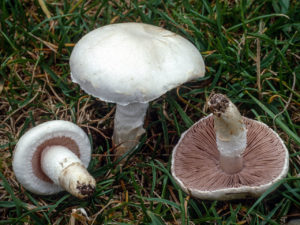
Meadow mushroom[iii] is a wide-spread species very similar to the domesticated white button, crimini, and portobello mushrooms (all of which are different ages and varieties of the same species, A. bisporus[iv]). Like them, it is good to eat, though only in moderation—and extra care must be taken with specimens growing near roads or other sources of chemical pollution, as these could be contaminated.
Care must also be taken to look at the color of the spores and the gills, as this species has several very dangerous look-alikes.
Two-Colored Bolete (Boletus Bicolor)

The Two-Color Bolete[v] is a choice edible that pairs well with red meat and can replace white buttons in most recipes. As the name implies, it usually has a yellow pore surface contrasting prettily with otherwise red coloration—but it’s not the only mushroom to look like that. It has several very close look-alikes, a situation compounded by extreme variability[vi]. Characteristics such as a distinctive odor that are sometimes given as a way to differentiate this species from its look-alikes are thus not reliable—and at least one of its close look-alikes is mildly toxic.
Giant Puffball (Calvatia gigantea)
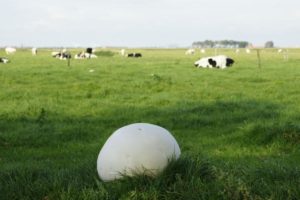
The Giant Puffball lives up to its name, often getting basket-ball sized or larger. While there is some overlap in size between this and some puffs that are merely very large, bigness is a good field-mark. As an edible, it really only has one drawback—it spoils quickly if not refrigerated, but is usually too big to fit in the fridge. Smaller Puffballs should always be cut vertically to make sure the inside is homogeneous, since from the outside they closely resemble Amanita eggs, some of which can kill a person. The giant puff is too big to confuse with an Amanita, but should still be inspected anyway, since once the spores start to mature, puffs are no longer edible.
Chanterelles (Cantharellus sp.) and Trumpets (Craterellus sp.)
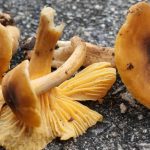


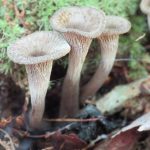
The chanterelles are another group of distinctive and delicious mushrooms. They, together with their cousins, the trumpets, are shaped more or less like the bell of a trumpet with ridges—not gills—along the outer surface of the bell. They may be flat-topped, indented, or somewhat hollow on top. While confusion with dangerous species is possible, identification is fairly sure as long as one remembers chanterelles and trumpets lack true gills. Illinois species include the Chicago Chanterelle (Cantharellus chicagoensis), the Appalachian Chanterelle (Cantharellus appalachiensis), the Black Trumpet (Craterellus fallax), and the Fragrant Black Trumpet (Craterellus foetidus). Note that “fragrant black trumpet” can apply to more than one species.
Lion’s Mane (Hericium erinaceus)
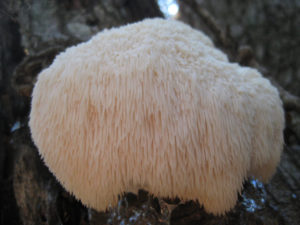
Lion’s Mane is close to being aptly named, as it is hairy (just not especially leonine). The thing is club-shaped, white to yellowish, and covered with soft, hair-like spines. Trekkies might be reminded of a white tribble. It eats trees, and usually fruits from a wound year after year.
Lion’s mane is edible (tastes like crab meat) and suspected of being medicinal (the research is preliminary but intriguing). It has two closely-related look-alikes that are also edible and not that difficult to tell apart, though they share the hair-like spines. Oddly, many writers refer to all three Hericiums as “lion’s mane,” treating them as medically interchangeable. There is no evidence for such equivalency. The others haven’t been researched.
Edible Amanitas (Amanita sp.)
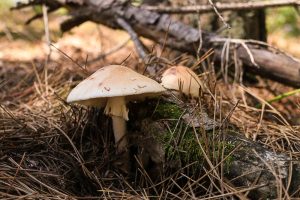

Mushrooms of the genus, Amanita are famously poisonous, yet there are a number of species in the group that are safe to eat—provided they are correctly identified, of course. Many experts advise never eating any Amanita, since the consequences of a mistake can kill a person. At least two of these edible species grow in Illinois, the Blusher (Amanita amerirubescens)[vii] and the American Caesar’s Mushroom—which is one of a poorly-understood group of species that resemble the European A. caesaria[viii]. Exactly which species of Caesar’s Illinois has is unclear.
Note that while neither The Blusher and Caesar’s mushroom are likely to be mistaken for the famously deadly Destroying Angels or The Deathcap, they are much more similar to A. muscaria and A. pantherina—two species that are not usually deadly but are still extremely dangerous, depending on how they are processed.
Honey Mushrooms (Armillaria sp.)
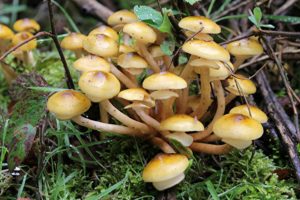
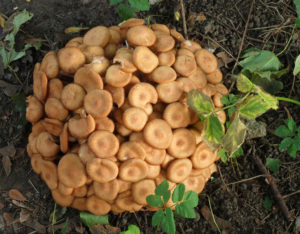
Honey mushrooms are named for their color, not their taste, but they are edible with two caveats. First, this is another group for which proper identification is critical, as they have a deadly look-alike. Second, a few people have gotten sick from eating honeys, possibly because of an unusual sensitivity, so some experts recommend nobody eat honeys, just to be safe. Illinois has two species, The Honey Mushroom (Armillaria mellea)[ix], and The Ringless Honey Mushroom (A. tabescens)[x]. They look very much alike.
Shaggy Mane (Coprinus comatus)
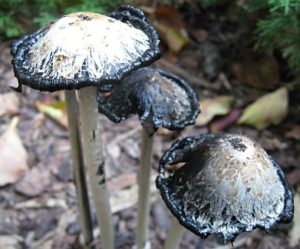
The shaggy mane[xi], like its cousin The Ink Cap, is shaped like an umbrella that never opens—only the ink cap isn’t shaggy. The two also share two other curious characteristics. First, rather than releasing their spores to the wind, both these species simply turn to black goo and drip away. The gooification begins at the lowermost edge of the cap and proceeds upward, the cap getting shorter and shorter until eventually the whole mushroom melts away. Second, both are edible but contain a toxin that activates only if the eater also drinks alcohol.
Magic Mushrooms in Illinois
Illinois also has its share of psychoactive mushroom species.[xii] It’s worth noting that while most of these are relatively safe to use, the emphasis is on “relatively.” If users follow proper safety protocols, such as not using too much and not “tripping” alone, risk can be minimized but not eliminated. Serious, even lethal, reactions are very rare but can occur. Also, most of the species on this list have a deadly look-alike. Proper identification is critical. The only one that really doesn’t resemble the Deadly Galerina is itself dangerously toxic if not processed properly.
It’s also important to remember that psilocybin, and any object that contains it, such as a mushroom, is extremely illegal according to both state and US law[xiii]. Getting caught can ruin a life.
Gymnopilus

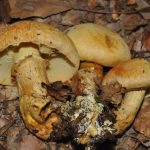
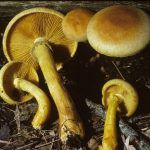
There are many Gymnopilus[xiv] species, but only a few of then are “active.” Few people used gyms, so there’s not much information available on what these mushrooms’ trops are like. Physically most of them are small and yellow-brown. Illinois has three species: G. braendlei, G. validipes, and G. luteus[xv].
Panaeolus cinctulus
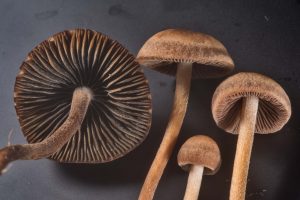
This one earns its common name, Banded Mottlegill,[xvi] by having an outer cap margin of a different color than the center, plus gills that develop dark spots as the spores mature in patches. It is weakly but definitely active. There are other pans that are more potent, but not in Illinois.
Pluteus
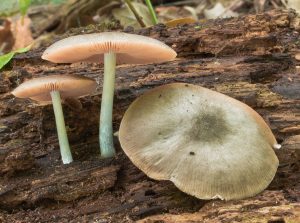
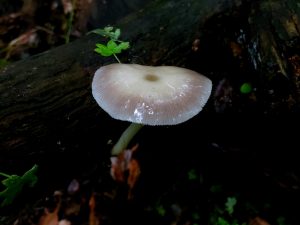
This genus[xvii] is better known for its several edible species, including the deer mushroom, but it also has a few “active” members, two of which, P. americanus[xviii] and P. saupei, live in Illinois.
Fly Agaric (Amanita muscaria)
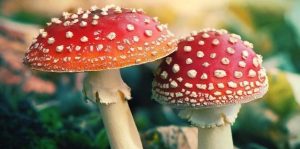
Unlike the other “magic mushrooms” on this list, A. muscaria does not contain psilocybin. It has a different “active ingredient” and therefor gives a very different trip experience. But A. muscaria (for some reason, few people use its common name) is also much more dangerous than the psilocybin mushrooms. Its different biochemistry is seriously toxic if not processed properly.
Poisonous Mushrooms in Illinois
Be aware that this list is not exhaustive; don’t assume that a mushroom not listed here is safe to eat. The following are simply some of those species it is most important to know and avoid.
Also, some of these mushrooms are pretty, and all have interesting and important ecological roles to play. There are no bad mushrooms, only some that shouldn’t be eaten.
False Morel (Gyromitra brunnea)

False morel and its relatives (sometimes called “false morels” collectively) do vaguely resemble morels, though their caps are wrinkled rather than pitted. However, most people who eat them do so on purpose. Just as morels sometimes poison people, even though “everybody knows” they are safe to eat, false morels are sometimes entirely pleasant as food, even though “everybody knows” they are toxic. They have their culinary devotees. However, there is some evidence that the toxin in false morels may be cumulative, meaning that a person can eat them for years with no adverse symptoms, then suddenly get very, very ill.
Jack O’Lantern (Omphalotus illudens)
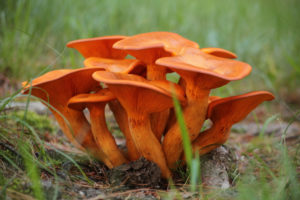
Jack o’lantern Mushroom[xix] is notable for glowing in the dark (very faintly), for resembling some species of chanterelle (very faintly, but people do make the mistake), and for being poisonous (not usually lethal, but rather more than faintly!). There is more than one Jack o’Lantern species, but this is the one in Illinois.
The Sickener (Russula sp.)
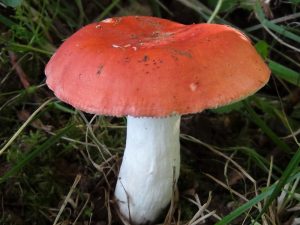
“Sickener” refers basically to any red-capped Russulas. These were once mostly lumped together as Russula emetica. More recently it has become obvious that Russula identification is a job for experts whose lives have been too easy lately and need some stress and failure to liven things up[xx]. The main point is don’t eat these. They are pretty, but aptly-named[xxi].
False Parasol (Chlorophyllum molybdites)
The simple version is that this species[xxii] is a toxic look-alike of the Shaggy Parasol. However, the name, “Shaggy Parasol” applies to multiple species, and distinctions within the group are a little unclear. Worse, some of the Shaggy Parasols are toxic sometimes, especially if old or undercooked, while false parasol is sometimes eaten without ill-effect, especially when well-cooked and young. So the group seems to contain a continuum from safe to dangerous, with this species anchoring the dangerous end of the scale. It’s not typically deadly, just extremely unpleasant. False parasol could also be mixed up with other edible species, including meadow mushroom, though as usual careful attention to detail should make identification clear.
Destroying Angel (Amanita sp.)
The name, “Destroying Angel,” refers to a group of very similar-looking species within the Amanita genus (Amanita bisporigera, Amanita ocreata and Amanita virosa). It’s not entirely clear which of these species live in Illinois, and it doesn’t really matter (except to mycologists) because all of them are all-white with a white spore print and the classic, handsome, Amanita shape, and all of them will probably kill anyone who eats a specimen. Mature specimens are not-infrequently mistaken for meadow mushrooms and parasols. Younger specimens, before the cap has fully opened, have been mistaken for Coprinus species. The early “egg” stage looks very much like certain puffballs. Distinguishing between destroying angels and those they resembles is seldom difficult, but does depend on careful attention to detail[xxiii].
Deadly Galerina (Galerina marginata)

The Deadly Galerina is a LBM or little brown mushroom, a small, brown, and nondescript group of mushrooms, like Honey Mushrooms, Enokitake, and most “magic” mushrooms, among others. Also, it contains the same toxin as The Destroying Angel, enough for a single mushroom to kill. Perhaps most frightening, it shares a habitat with some of its look-alikes, and can even grow within the clumps of the others. Identifying every single mushroom is critical[xxiv].

My name is Austin Collins.
I've dedicated my life to Mushrooms.
I believe Mushrooms are the best kept secret when it comes to health and well being.
For that reason, I would like to share a company with you that in my opinion makes the best mushroom products on the market.
The company is called Noomadic Herbals, my favorite supplement they make is called "Mushroom Total".
I take their products every day and they have helped me think better and have more energy. Give them a try.
-Austin
References:
[i] Harvey, P. (2011). Species List: Fungi from Illinois (214). Mushroom Observer
[ii] Pankau, R. (2021). Tread Lightly as the Hunt Begins for Morel Mushrooms. Illinois Extension
[iii] (n.d.). Agaricus campestris L. –Field Mushroom. First Nature
[iv] (n.d.). Agaricus bisporus. Wikipedia
[v] Von Frank, A., von Frank, S. (2020). Bicolor Bolete (Baorangia bicolor)–How to Find, ID. And Eat this Wild Gourmet Mushroom. Tyrant Farms
[vi] Kuo, M. (2015). Boletus bicolor. MushroomExpert
[vii] Bergo, A. (n.d.). Amanita amerirubescens. Forager Chef
[viii] Pinzone, P. (2018). Fungi Friday—Amanita caesaria. Forest Floor Narrative
[ix] (n.d.). Armillaria mellea (Vahl) P. Kumm. –Honey Fungus. First Nature
[x] (n.d.). Armillaria tabescens (Scop) Emel—Ringless Honey Fungus. First Nature
[xi] (n.d.). Coprinus comatus (O.F. Müll.) Pers.—Shaggy Inkcap. First Nature
[xii] (n.d.). Which Psilocybin Mushrooms Grow Wild in My Area? Shroomery
[xiii] (n.d.). Psilocybin in Illinois: Magic Mushrooms in IL, USA Legal Guide. Psilocybin
[xiv] (n.d.). Gymnopilus. Wikipedia
[xv] Kuo, M. (2012). Gymnopilus luteus. MushroomExpert
[xvi] (n.d.). Panaeolus cunctulus. Philosophy
[xvii] Kuo, M. (2015). The Genus Pluteus. MushroomExpert
[xviii] Kuo, M. (2016). Pluteus americanus. MushroomExpert
[xix] (n.d.). Omphalotus illudens (Schwein.) Bresinky & Besl—Jack o’Lantern. First Nature
[xx] Kuo, M. (2009). The Genus Russula. MushroomExpert
[xxi] (n.d.). Russula emetica (Schaeff.)Pers.—The Sickener. First Nature
[xxii] (n.d.). Chlorophyllum molybdites—False Parasol. Texas Mushrooms
[xxiii] Illinois Department of Natural Resources (2021). Destroying Angel. Biodiversity of Illinois.
[xxiv] (n.d.). Galerna marginata. Illinois Mushrooms


